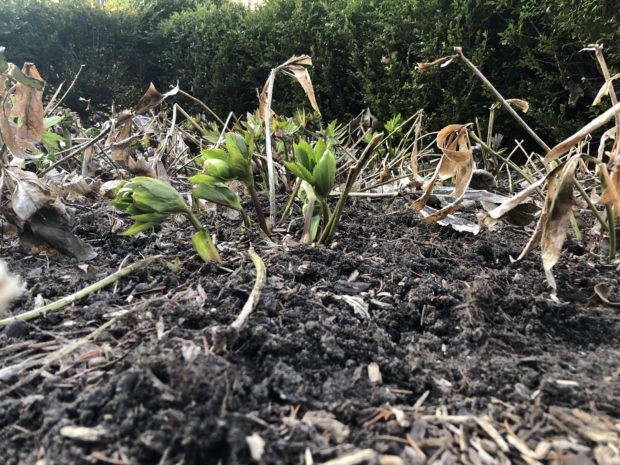 The hellebores do not have to compete very hard for my attention in the spring. They are just about the only perennial game in town come late March and on into April. I will admit I am out there searching for signs of them when the ground is still frozen solid. I am an enthusiast, yes. They are well worth the wait. Helleborus X hybridus-a group thought to be made up of 14 to 16 other species – is quite hardy in my zone. Other species and their hybrids, notably helleborus niger, are a little touchy for me, but well worth a try. The large leathery leaves populate sturdy compact plants, and are a rich dark glossy green. That foliage not only makes for a fine overscaled ground cover in shadier places throughout the growing season, it persists well into our winter. They prefer compost laden soil, regular moisture, and part shade conditions. That said, I have grown them successfully in full sun, and in deep shade. They are most obliging.
The hellebores do not have to compete very hard for my attention in the spring. They are just about the only perennial game in town come late March and on into April. I will admit I am out there searching for signs of them when the ground is still frozen solid. I am an enthusiast, yes. They are well worth the wait. Helleborus X hybridus-a group thought to be made up of 14 to 16 other species – is quite hardy in my zone. Other species and their hybrids, notably helleborus niger, are a little touchy for me, but well worth a try. The large leathery leaves populate sturdy compact plants, and are a rich dark glossy green. That foliage not only makes for a fine overscaled ground cover in shadier places throughout the growing season, it persists well into our winter. They prefer compost laden soil, regular moisture, and part shade conditions. That said, I have grown them successfully in full sun, and in deep shade. They are most obliging.
 In an especially wet year, I will see some botrytis, but in general, the plants are healthy and hardy. They are slow to put on weight, but once they do, they bloom profusely. They are very long lived. I have more than a few that are better than 20 years old. I hear they are not so happy to be divided, so I have stayed away from that. Their bloom story is equally as interesting. The thick juicy flowering stalks emerge first in the spring. Each flower is surrounded by leaflets. The flower shapes and colors, given intense hybridizing efforts all over the world, are incredibly diverse. Black, white, green, red, yellow and pink are all represented in varying shades and combinations of shades. Flowers can be single, anemone flowered, or double. In my opinion, the single flowered varieties are the most persistent and longest lived. The doubles with huge petal counts are fascinating, but the singles are my favorite. A green flowered single is my favorite of all.
In an especially wet year, I will see some botrytis, but in general, the plants are healthy and hardy. They are slow to put on weight, but once they do, they bloom profusely. They are very long lived. I have more than a few that are better than 20 years old. I hear they are not so happy to be divided, so I have stayed away from that. Their bloom story is equally as interesting. The thick juicy flowering stalks emerge first in the spring. Each flower is surrounded by leaflets. The flower shapes and colors, given intense hybridizing efforts all over the world, are incredibly diverse. Black, white, green, red, yellow and pink are all represented in varying shades and combinations of shades. Flowers can be single, anemone flowered, or double. In my opinion, the single flowered varieties are the most persistent and longest lived. The doubles with huge petal counts are fascinating, but the singles are my favorite. A green flowered single is my favorite of all.
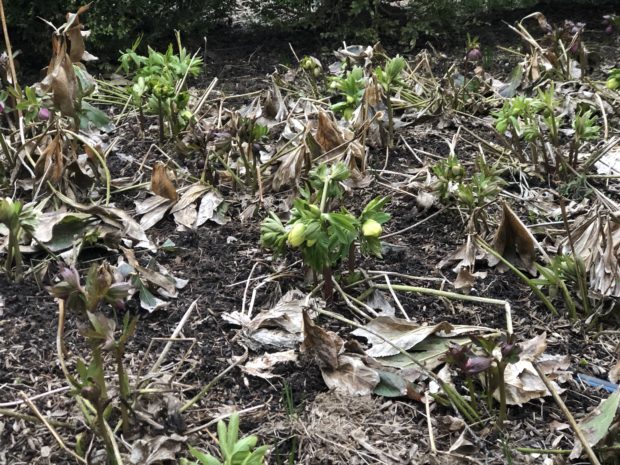 Once the bloom period is well underway, the plants send up new foliage. The foliage pictured above is the remains of the previous year’s leaves. In a perfect world, I would cut off the previous season’s leaves just prior to the flower stalks emerging. Should I miss that moment, I try to wait until the flowers are well out of the ground. Few gardening mishaps are as frustrating as cutting off soon to flower stalks by accident. I have done it more times than I care to remember.
Once the bloom period is well underway, the plants send up new foliage. The foliage pictured above is the remains of the previous year’s leaves. In a perfect world, I would cut off the previous season’s leaves just prior to the flower stalks emerging. Should I miss that moment, I try to wait until the flowers are well out of the ground. Few gardening mishaps are as frustrating as cutting off soon to flower stalks by accident. I have done it more times than I care to remember.
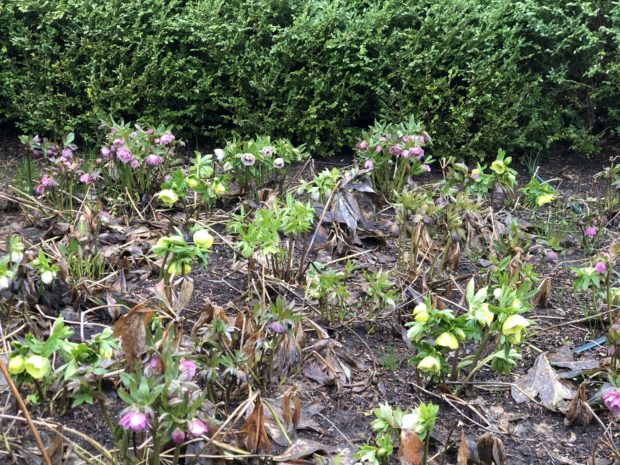 What you are seeing above is a trim long past due. The scraggly brown leaves of yesteryear are not adding much to the flowering stalks coming on. David usually cuts the old foliage off, as it would require that I leap over the boxwood hedge to get within snipping distance. At 6′ 3″ tall, he is able to step over. But he is at home in his own garden, tending to his own hellebores now, as well he should be. So I am stuck with a view, and not a presence. As it doesn’t bother me enough to risk getting there, I am intrigued to see how the plants will handle the chaos.
What you are seeing above is a trim long past due. The scraggly brown leaves of yesteryear are not adding much to the flowering stalks coming on. David usually cuts the old foliage off, as it would require that I leap over the boxwood hedge to get within snipping distance. At 6′ 3″ tall, he is able to step over. But he is at home in his own garden, tending to his own hellebores now, as well he should be. So I am stuck with a view, and not a presence. As it doesn’t bother me enough to risk getting there, I am intrigued to see how the plants will handle the chaos.
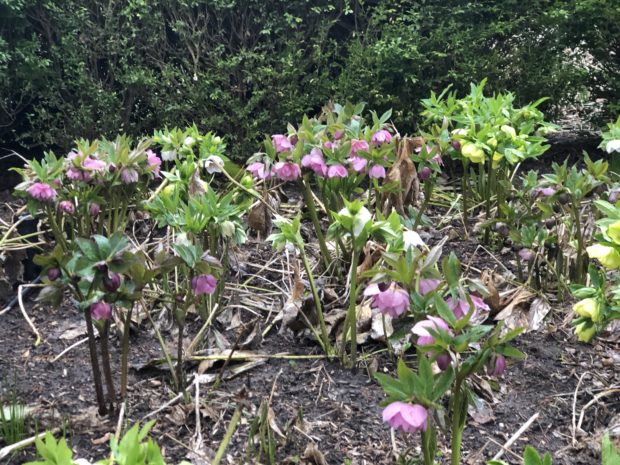 Several weeks in, it does not appear that any of these flowering stalks are hanging back or hindered by the lack of a cleanup. They actually seem quite indifferent to the mess. This is a rather unattractive moment, but it does illustrate the the process of nature cycling from one growing season to the next. Were I to try to get in there now and try to scoop up all the detritus, I feel every plant would be glaring at me. Years ago a friend with an extraordinary wildflower garden told me she worked very hard to see that her garden was undisturbed by her presence as much as possible. She limited her house keeping to the removal of downed limbs and branches, and all but a reasonable layer of oak leaves in the fall. Her garden was stunning. Large drifts of the same plant took hold in those spots optimal for their success. It had a relaxed and natural appearance as it was minimally and judiciously tended. Plants that have been fussed with too much have that look about them.
Several weeks in, it does not appear that any of these flowering stalks are hanging back or hindered by the lack of a cleanup. They actually seem quite indifferent to the mess. This is a rather unattractive moment, but it does illustrate the the process of nature cycling from one growing season to the next. Were I to try to get in there now and try to scoop up all the detritus, I feel every plant would be glaring at me. Years ago a friend with an extraordinary wildflower garden told me she worked very hard to see that her garden was undisturbed by her presence as much as possible. She limited her house keeping to the removal of downed limbs and branches, and all but a reasonable layer of oak leaves in the fall. Her garden was stunning. Large drifts of the same plant took hold in those spots optimal for their success. It had a relaxed and natural appearance as it was minimally and judiciously tended. Plants that have been fussed with too much have that look about them.
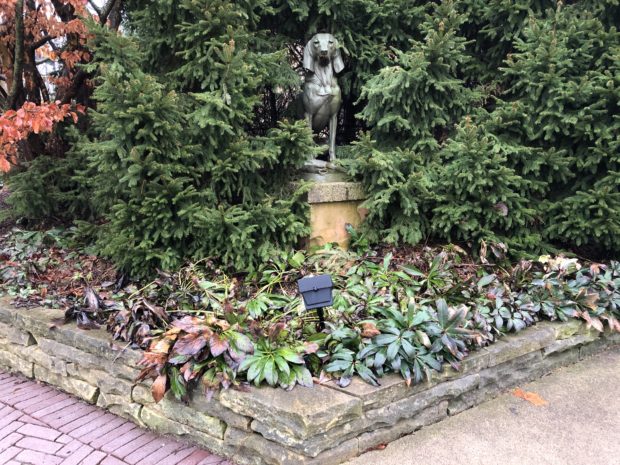 This area will surely test that hands off experiment. This first of this group of hellebores were planted decades ago. Should one succumb, I plant another. It is a spot that I can readily reach. But I am interested to see what will come of a hands off approach.
This area will surely test that hands off experiment. This first of this group of hellebores were planted decades ago. Should one succumb, I plant another. It is a spot that I can readily reach. But I am interested to see what will come of a hands off approach.
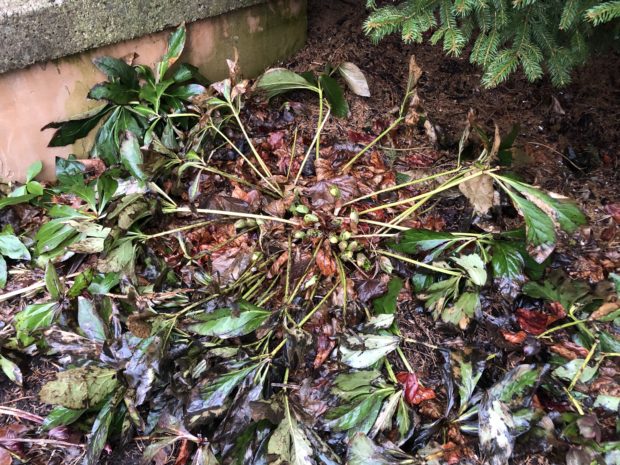 This old clump of Royal Heritage strain will have lots and lots of flowers. At this stage, it is hard to imagine this plant occupying every bit of four square feet. As they are planted on the north side of a sizeable picea mucrunatum, they are slower to come on in the spring.
This old clump of Royal Heritage strain will have lots and lots of flowers. At this stage, it is hard to imagine this plant occupying every bit of four square feet. As they are planted on the north side of a sizeable picea mucrunatum, they are slower to come on in the spring.
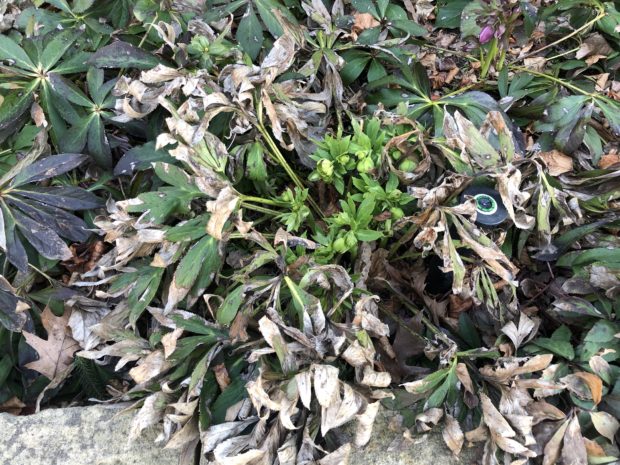 All of them seem to be putting forth fresh growth.
All of them seem to be putting forth fresh growth.
 This stage is every bit as beautiful as the flowering stalks fully flushed out.
This stage is every bit as beautiful as the flowering stalks fully flushed out.
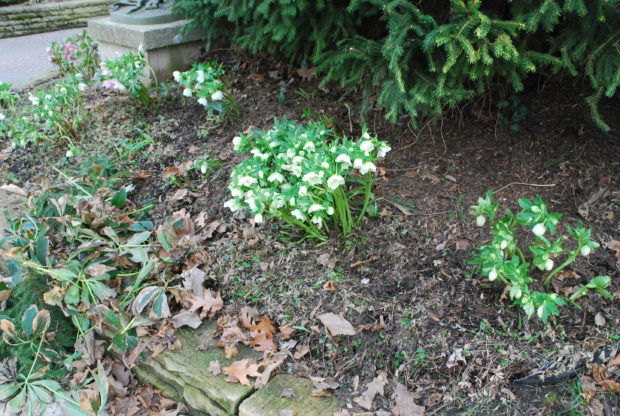 Is this a better look? I will soon have an alternate treatment available to look at.
Is this a better look? I will soon have an alternate treatment available to look at.
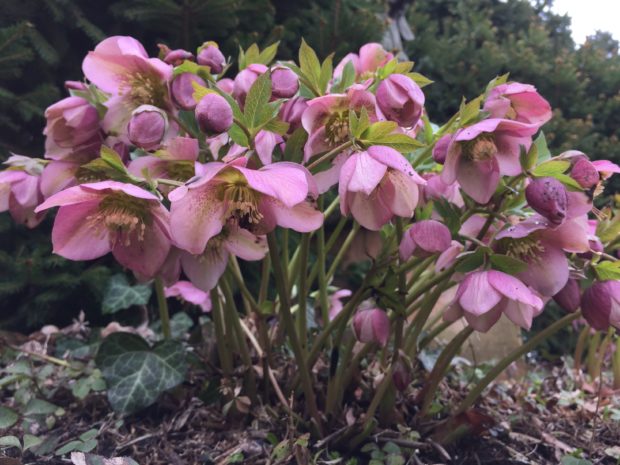 It could be by the time this hellebore is at this particular stage, I will barely notice what did not get done.
It could be by the time this hellebore is at this particular stage, I will barely notice what did not get done.